If you’ve noticed a lump or swelling has appeared on your hand or wrist, you may be wondering what it could be. While there are a few different conditions that could cause these bumps to appear, one of the most common that you may be suffering from is a ganglion cyst. Ganglion cysts are noncancerous growths that most typically appear on the back of the hand or wrist, and while they are usually harmless, they can sometimes cause pain, discomfort, or limit the individual’s range of motion.
The good news is that you don’t have to suffer in silence. At the Sydney Orthopaedic Surgeon Clinic, we specialise in the diagnosis and treatment of ganglion cysts, and we are dedicated to providing effective and personalised care to every patient. From non-surgical treatments like immobilising the area or engaging in aspiration to more advanced surgical techniques, we offer a range of options to help relieve your symptoms and improve your quality of life.
Whether you’re experiencing mild discomfort or more severe pain and discomfort, the Sydney Orthopaedic Surgeon Clinic is here to help. Don’t hesitate to contact our friendly team to schedule a consultation with Dr Stuart Kirkham, our experienced and dedicated orthopaedic surgeon. Let’s work together to find the best solution for you and get you back to living your life to the fullest.
Anatomy Related To Ganglion Cysts
To understand ganglion cysts, it’s helpful to first have a basic understanding of the anatomy of joints, tendons, and ligaments that sit within the areas where ganglion cysts may form. Joints are the meeting point where two bones come together, and they facilitate movement. Tendons serve a slightly different purpose, as they connect muscles to bones and allow for coordinated movement. Ligaments, on the other hand, connect bones to other bones to provide stability to the overall joint.
Within each of the joints, there is a fluid called synovial fluid, and this acts as a lubricant to reduce friction between bones and other structures. This fluid is absolutely crucial to maintaining the health of the joint and ensuring it can function smoothly and without any pain or discomfort.
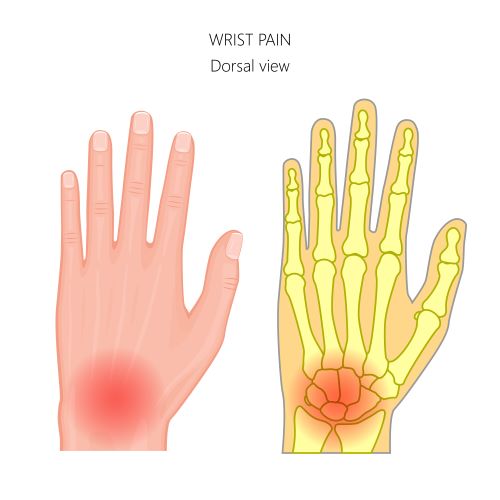
So, how do ganglion cysts form amongst all this anatomy? Ganglion cysts are filled with synovial fluid, and they typically develop near joints or tendons. These cysts form when there is an abnormal accumulation of synovial fluid that leaks out of a joint or tendon sheath. This excess fluid then collects and forms a sac or cyst, which can range in size from a small pea to a large grape.
While ganglion cysts can occur in any part of the body, they are most commonly found in the wrist and hand. They can also develop on the ankle or foot, as well as the knee or shoulder.
If you’re experiencing any symptoms that may be indicative of a ganglion cyst, it’s important to seek medical attention to determine the best course of action for your individual case. Dr Stuart Kirkham from the Sydney Orthopaedic Surgeon Clinic has over 25 years of experience in the diagnosis and treating ganglion cysts, so why not schedule a consultation today and take the first step towards getting relief from your symptoms?
Causes and Risk Factors For Ganglion Cysts
While the exact cause of ganglion cysts is not fully understood, there are several factors that may contribute to their formation. Ganglion cysts are most commonly associated with injuries that weaken the fibres of the ligaments, typically within the wrist, causing an abnormal accumulation of synovial fluid. This vast volume of synovial fluid within one area of the body can eventually lead to the formation of a cyst. In some cases, ganglion cysts may instead develop a consequence of wear and tear on joints or tendons that has occurred over a prolonged period.
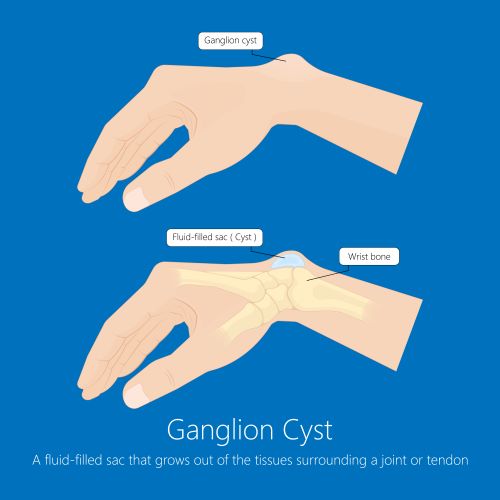
The gender and age and age of an individual may also predispose them to the development of ganglion cysts. A vast body of research has indicated that women are more likely to develop ganglion cysts than men, and these conditions are most commonly seen in individuals between the ages of 20 and 40.
Specified occupations may also increase the risk of an individual developing a ganglion cyst. Jobs that require an individual to conduct repetitive motions or use their hands and wrists heavily can contribute to the onset of this condition. As a result, athletes, musicians, and manual labourers are all at increased risk of developing ganglion cysts. While these conditions have typically been attributed to continual typing and other repetitive activities in isolation, this is not entirely accurate. While these activities can contribute to joint or tendon injuries that may lead to the formation of a cyst, they are not a direct cause of ganglion cysts.

While it may be difficult to determine exactly why a ganglion cyst has developed, it’s important to seek medical attention and offer insight into your experience. This will allow an individualised course of action to be devised, as this will not only help alleviate the symptoms you face but also work towards ensuring they don’t occur again in future. Dr Stuart Kirkham from the Sydney Orthopaedic Surgeon Clinic has great experience with ganglion cysts and can offer personalised treatment plans tailored to your needs.
Symptoms and Identification Of Ganglion Cysts
Ganglion cysts can develop in any joint or tendon in the body, but they are most commonly found in the hands and wrists. These cysts often appear as small, round, or oval-shaped lumps that are filled with a clear, jelly-like fluid, which is the synovial fluid. The cysts can range in size from a pea to a golf ball, and they may be soft or firm to the touch.
In many cases, ganglion cysts do not cause any symptoms and are discovered incidentally during a routine physical examination. However, in more severe cases where symptoms are present, they may include pain, tenderness, or a dull ache in the affected joint or tendon. The cysts may also cause discomfort or interfere with their range of motion, making it difficult to perform everyday tasks such as gripping or grasping objects.

Ganglion cysts can also cause nerve compression, leading to tingling, numbness, or weakness in the affected area. If the cyst is located near a nerve, it can cause pain or discomfort that radiates to other areas of the body. In some cases, the cyst may interfere with the blood supply to the affected area, leading to discolouration or swelling.
If you are experiencing any of these symptoms, don’t let ganglion cysts impact your daily life. Early diagnosis and treatment are important to prevent the cyst from growing larger and potentially causing more severe symptoms. Don’t let ganglion cysts impact your daily life. Dr Stuart Kirkham from the Sydney Orthopaedic Surgeon Clinic can provide expert evaluation and management of your symptoms, helping you find relief and regain function in the affected joint or tendon.
Diagnosis and Imaging Of Ganglion Cysts
If you’re experiencing symptoms of a ganglion cyst, the first step towards diagnosis is a physical examination by a qualified medical professional. Dr Stuart Kirkham from the Sydney Orthopaedic Surgeon Clinic specialises in the diagnosis and treatment of ganglion cysts, and he can conduct a range of different exams to diagnose the condition.
During a physical examination, Dr Kirkham will carefully assess the affected area, looking closely for any lumps, swelling, or other abnormalities. He may also ask you to move the joint to assess your range of motion and identify any areas of tenderness or discomfort.
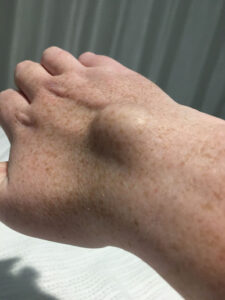
In some cases, imaging techniques such as X-ray, ultrasound, or MRI may be used to help diagnose a ganglion cyst. X-rays can help rule out other conditions, such as arthritis or bone tumours, while ultrasound and MRI are more useful for identifying soft tissue abnormalities such as ganglion cysts.
Differentiating between ganglion cysts and other growths is hugely important as it ensures the
Once a diagnosis has been made, Dr Kirkham can work with you to create a customised treatment and recovery plan that will alleviate the symptoms you face and allow you to continue carrying out your daily activities with ease.
Patients with symptomatic cysts often describe difficulty with yoga, push-ups or any similar activity that involves placing their hand flat on a surface – such as a bench or a floor.
The success rates of treatment for ganglion cysts are generally high, with most patients experiencing relief from symptoms and a reduction in the size of the cyst. While any medical procedure does have some potential complications, such as infection, nerve damage, or recurrence of the cyst, Dr Kirkham has successfully completed these surgeries many times. He will also discuss these risks with you before any treatment and will take proactive steps to minimise the risk of complications.
Dr Kirkham understands that there is the potential for a recurrence after surgery, but as a result, Dr Kirkham very often suggests that his patients proactively reduce these risks by purchasing and wearing a removable wrist splint for up to 6 weeks after wrist ganglion surgery. If the initiating event is kept quiet, (ie if synovial fluid production is kept to a minimum), then it is logical that any cyst reformation during the crucial early post-operation healing period will also be kept to a minimum.
Living with the discomfort and limitations caused by a ganglion cyst can be challenging, but you don’t have to face it alone. We can offer expert evaluation and management of ganglion cysts, providing personalised treatment plans to help you achieve optimal joint and tendon health. Don’t let ganglion cysts hold you back any longer. Contact us today to schedule a consultation and learn more about how we can help you find relief from your symptoms and improve your quality of life.
Treatment Options For Ganglion Cysts
Treatment options for ganglion cysts depend on the severity of the symptoms and the location of the cyst. In some cases, ganglion cysts may resolve on their own without any treatment. However, if the cyst is causing discomfort or interfering with your daily life, specialised treatment may be necessary. Dr Stuart Kirkham from the Sydney Orthopaedic Surgeon Clinic has conducted a range of different treatments for this condition, and he can help you determine the best course of action for your individual case.
Non-surgical options for treating ganglion cysts include watchful waiting, immobilisation, and aspiration. Watchful waiting simply involves monitoring the cyst closely to see if it resolves on its own. This may see the individual use anti-inflammatory medications to manage their pain. Immobilisation is another non-surgical form of treatment that takes more proactive steps towards the patient’s recovery, seeing them wear a splint or brace to limit movement and prevent further irritation. Aspiration involves using a needle to drain the fluid from the cyst, and this can relieve symptoms and will reduce the size of the cyst.
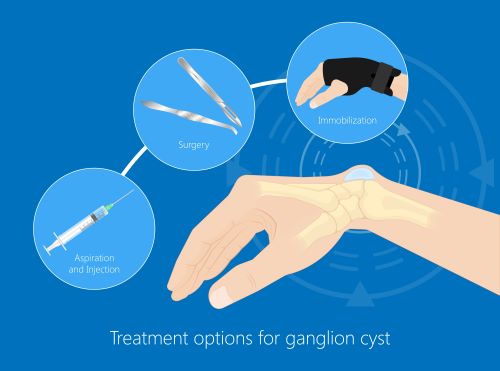
However, the severity of some cases means that surgical options may need to be explored to remove the cyst altogether. Open surgery involves making an incision to remove the cyst, while arthroscopic surgery involves using a small camera to guide the removal of the cyst through a smaller incision. Dr Kirkham will discuss the pros and cons of each option with you to determine the best course of action.
Factors that may influence the choice of treatment include the size and location of the cyst, the severity of the symptoms the patient faces, and the individual’s medical history. Generally, non-surgical options are preferred for smaller cysts that are not causing significant symptoms, while surgical options may be necessary for larger cysts or those that are interfering with daily activities.
The success rates of treatment for ganglion cysts are generally high, with most patients experiencing relief from symptoms and a reduction in the size of the cyst. While any medical procedure does have some potential complications, such as infection, nerve damage, or recurrence of the cyst, Dr Kirkham has successfully completed these surgeries many times. He will also discuss these risks with you before any treatment and will take proactive steps to minimise the risk of complications.
Living with the discomfort and limitations caused by a ganglion cyst can be challenging, but you don’t have to face it alone. We can offer expert evaluation and management of ganglion cysts, providing personalised treatment plans to help you achieve optimal joint and tendon health. Don’t let ganglion cysts hold you back any longer. Contact us today to schedule a consultation and learn more about how we can help you find relief from your symptoms and improve your quality of life.
Prevention and Aftercare For Ganglion Cysts
While the development of ganglion cysts cannot always be prevented, there are steps you can take to reduce the risk of developing them. These include avoiding repetitive motions or overuse of the affected joint or tendon, maintaining good joint health through regular exercise and stretching, and protecting the affected area from injury.
After treatment for a ganglion cyst, it’s important to follow your doctor’s aftercare instructions to ensure a full and speedy recovery. This may include rest, physical therapy, or the use of splints or braces to support the affected joint during the healing process.
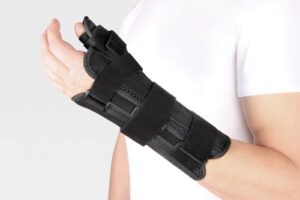
Recurrence of ganglion cysts is possible, and some patients may develop new cysts in the same or different areas after treatment. To minimise the risk of recurrence, it’s important to continue to take steps to protect and maintain the health of the affected joint or tendon.
Dr Kirkham is aware of the recurrence rate after surgery and to actively prevent these complications, Dr Kirkham will very often suggest that patients buy and wear a removable wrist splint for up to 6 weeks after wrist ganglion surgery. If the initiating event is managed effectively, (ie if synovial fluid production is kept to a minimum), then it is logical that any cyst reformation during the crucial early post-operative healing period will also be kept to a minimum.
If you do experience recurring symptoms or a new ganglion cyst appears, it’s important to seek medical attention promptly. Dr Stuart Kirkham from the Sydney Orthopaedic Surgeon Clinic can provide comprehensive care and support for all stages of ganglion cyst treatment and recovery.
Contact us today to schedule a consultation and learn more about how we can help you find relief from your symptoms and get back to your normal daily activities.
The Recovery Process For Ganglion Cysts
The recovery process for ganglion cyst treatment can vary depending on the severity of the symptoms and the chosen treatment option. Dr Stuart Kirkham from the Sydney Orthopaedic Surgeon Clinic will provide you with specific instructions regarding your recovery timeline and expectations.
After non-surgical treatment, such as aspiration or immobilisation, it’s most likely that you will be able to return to your normal activities within a few days to a week. However, it’s important to avoid any activities that may cause irritation or reinjury to the affected joint or tendon.
If surgical treatment is necessary, the duration of your recovery will naturally be longer, and may take several weeks or months, depending on the type of surgery and the location of the cyst. Dr Kirkham will provide you with specific instructions for post-operative care and rehabilitation exercises to promote healing and restore range of motion.

Managing pain and swelling is an important aspect of the recovery process that mustn’t be neglected. You may be advised to use ice or heat therapy, take over-the-counter pain medication, or use a compression bandage to reduce pain and swelling. Physical therapy and rehabilitation exercises may also be recommended to improve the range of motion, restore muscle strength, and promote healing.
Dr Kirkham will provide you with specific instructions and a customised rehabilitation plan tailored to your individual needs and recovery goals.
Returning to normal activities may take some time, depending on the severity of your symptoms and the type of treatment you received. Dr Kirkham will provide you with specific guidelines regarding when you can resume certain activities, such as sporting activities or heavy lifting, to avoid reinjury or exacerbation of symptoms.
Possible Complications Of Ganglion Cysts
While ganglion cysts are usually benign and often don’t require treatment, leaving them untreated can lead to a variety of complications. If left untreated, ganglion cysts can continue to grow and cause pain, and discomfort, and limit the individual’s range of motion in the affected joint or tendon. Over time, the cyst can compress nearby nerves, leading to tingling, numbness, or weakness in the affected area. In some cases, the cyst can even cause nerve damage or lead to chronic pain.
Another potential complication of untreated ganglion cysts is the risk of infection. If the cyst ruptures or becomes inflamed, it can lead to an infection that can spread to other parts of the body. Infection can cause fever, swelling, and redness around the affected area, and may require antibiotics or other treatments to resolve.
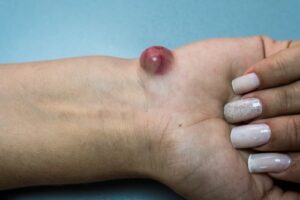
In addition, an untreated ganglion cyst untreated can increase the risk of scarring and adhesions. Over time, the cyst can cause damage to nearby tissues and tendons, leading to the formation of scar tissue and adhesions that can interfere with joint and tendon function. Scar tissue and adhesions can also make it more difficult to treat the cyst in the future, increasing the likelihood of recurrence.
So, if you are experiencing symptoms of a ganglion cyst, it’s important to seek medical attention promptly to avoid these potential complications. Dr Stuart Kirkham from the Sydney Orthopaedic Surgeon Clinic can offer his great expertise to provide personalised advice that will help to minimise the risk of complications. Contact us today to schedule a consultation and learn more about how we can help you achieve optimal joint and tendon health.
Are You Concerned About Ganglion Cysts?
Ganglion cysts are a common condition that can cause discomfort and interfere with daily activities, but there are effective treatment options available to help alleviate symptoms and improve quality of life. Non-surgical treatments can be effective in managing early-stage cysts, while surgical options such as open surgery or arthroscopic surgery can provide long-term relief for more advanced cases.
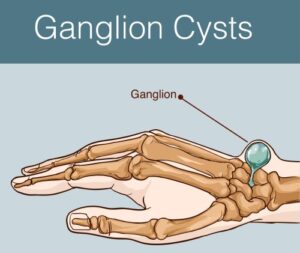
At the Sydney Orthopaedic Surgeon Clinic, we understand the impact that ganglion cysts can have on your life, and we are dedicated to providing personalised, compassionate care to help you achieve optimal joint and tendon health. Our team of healthcare professionals offer a comprehensive range of treatment options for ganglion cysts, tailored to your individual needs and goals.
If you are experiencing symptoms of a ganglion cyst, it’s important to seek medical attention promptly. Dr Stuart Kirkham from the Sydney Orthopaedic Surgeon Clinic can provide an accurate evaluation and offer treatment approaches that will manage your symptoms, helping you find relief and regain function in the affected joint or tendon.
Contact the Sydney Orthopaedic Surgeon Clinic today to schedule a consultation and take the first step towards finding relief from your symptoms and achieving optimal joint and tendon health.
Frequently Asked Questions
1. Are ganglion cysts dangerous?
Ganglion cysts are typically not considered dangerous or life-threatening. They are benign and rarely become cancerous. They are generally more annoying and pesty rather than dangerous. However, if the cyst is located near a nerve or if it is causing significant discomfort or interfering with daily activities, treatment may be necessary. Neglecting treatment can lead to increased pain, discomfort, and loss of function in the affected joint or tendon.
2. How long does recovery take after ganglion cyst surgery?
Recovery after ganglion cyst surgery can vary depending on the severity of the cyst and the type of surgery performed. For less invasive procedures such as aspiration, recovery can take a few days to a few weeks. For more complex surgeries, recovery can take several weeks to months for the affected area to fully heal and for normal activities to be resumed. The exact timeline will depend on the individual case and the extent of the surgical procedure. Six weeks of removable splinting is often part of the after are for a wrist ganglion procedure.
3. Can ganglion cysts come back after treatment?
Yes, ganglion cysts can recur after treatment, particularly if the underlying cause of the cyst is not addressed. The likelihood of recurrence varies depending on the individual case and the treatment option chosen. For example, aspiration has a higher recurrence rate than surgical removal. To minimise the risk of recurrence, it’s important to follow your doctor’s instructions for aftercare and to take steps to protect and maintain the health of the affected joint or tendon.
Dr Kirkham is aware of the recurrence rate after surgery, and to minimise the chances of these complications from occurring, Dr Kirkham will very often suggest that patients buy and wear a removable wrist splint for up to 6 weeks after wrist ganglion surgery. If the initiating event is kept quiet, (ie if synovial fluid production is kept to a minimum), then it is logical that any cyst reformation during the crucial early post-operative healing period will also be kept to a minimum.
4. Is non-surgical treatment available for ganglion cysts?
Yes, non-surgical treatment options for ganglion cysts include watchful waiting, immobilisation, and aspiration. However, the most appropriate treatment option will depend on the severity of the cyst and the individual case. Non-surgical treatments may be effective for smaller cysts or those that are not causing significant discomfort or interfering with daily activities. Dr Stuart Kirkham from the Sydney Orthopaedic Surgeon Clinic can help determine the best course of action for your individual case.
5. Can ganglion cysts cause nerve damage?
In rare cases, ganglion cysts can cause nerve damage if they are located near a nerve or if the nerve is accidentally damaged during treatment. However, this is uncommon and can often be avoided with proper treatment and care. It’s important to seek medical attention promptly if you experience symptoms such as numbness, tingling, or weakness in the affected area. Dr Stuart Kirkham from the Sydney Orthopaedic Surgeon Clinic can provide comprehensive care and support for all stages of ganglion cyst treatment and recovery, including identifying and managing any potential complications.
6. Do ganglion cysts go away without any treatment?
In some cases, ganglion cysts may resolve on their own without any specific treatment. This spontaneous resolution can occur when the cyst ruptures and the fluid is reabsorbed by the body. However, it’s important to note that ganglion cysts do not always go away on their own, and they may persist or even grow larger over time. If the cyst is causing pain, discomfort, or functional limitations, seeking medical evaluation and appropriate treatment is recommended.
7. Are ganglion cysts painful?
Ganglion cysts can cause pain and discomfort, particularly when they press on nerves or surrounding tissues. The pain may range from mild to moderate and can worsen with certain movements or activities. The level of pain experienced can vary among individuals and depends on the location and size of the cyst. If a ganglion cyst is causing persistent pain or interfering with daily activities, seeking medical evaluation is advisable for proper diagnosis and management. Dr Kirkham is a ganglion cyst specialist with great experience in removing these painful lumps. Whether you’re suffering from a ganglion cyst in metropolitan Sydney or you’re suffering from a ganglion cyst in Bowral or Sydney’s surrounds, Dr Kirkham is ready to assist you and help you enjoy a pain-free daily experience.
8. Why do ganglion cysts form?
The exact cause of ganglion cyst formation is not fully understood. However, they are believed to develop due to irritation or trauma to nearby tendons or joints. Ganglion cysts are filled with synovial fluid, which is the lubricating fluid found in joints. When there is an overproduction of synovial fluid or a blockage in the joint or tendon, the fluid can accumulate and form a cyst. Certain repetitive movements or activities that strain a specific joint or tendon may also contribute to the development of ganglion cysts. While the precise cause may vary among individuals, seeking professional evaluation and treatment by a specialist like Dr. Stuart Kirkham can help manage and address ganglion cysts effectively.
References
- Better Health Channel (Cysts – Ganglion Cysts)
- Mayo Clinic (Ganglion Cysts)
- Ortho Info (Ganglion Cyst of the Wrist and Hand)
- American Society For Surgery of the Hand (Ganglion Cyst)
- Nationwide Children’s (Ganglion Cysts)


